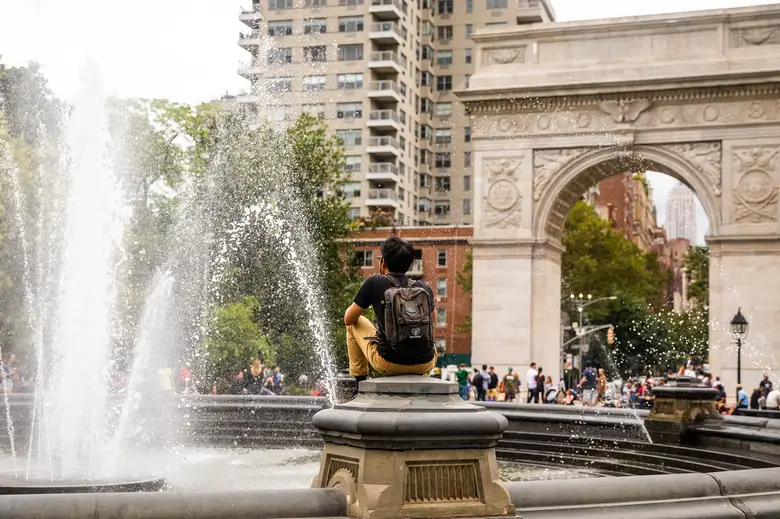College Essay Examples: 7 Essays From Students Who Got Into Top Schools

7 College Essays That Worked
What makes a great college essay? It's more art than science, but these essay examples can give you a sense of what makes a good essay.
Starting your college admissions essay can feel like a monumental task, and staring at a blank screen may only make things worse. To help inspire you, College Confidential is relaunching a series in which we share personal essays from students who were admitted to college during a prior admissions cycle. Read on to see real essays that got students into top schools, including: University of North Carolina, Chapel Hill, Stanford, NYU, Northeastern, University of Virginia, and Tufts.
UNC Chapel Hill Admissions Essay Example

The student that wrote this essay was admitted to University of North Carolina, Chapel Hill. College Confidential is sharing this essay with his permission
Picture this: A small, 13-year-old boy soaked in sweat, throwing his body onto a handrail in the blistering heat. Whereas the initial thought of this seems jarring, the reality was that everyone nearby continued to go about their business, not really noticing the kid.
That boy was me — on one of the most memorable days I had ever experienced.
As a beginner to the skateboarding world, I was trying repeatedly to master a trick that would allow me to take my board down a handrail and onto a ramp. Each time I attempted the trick, I landed on the hot concrete with a thud. However, the sound of my body hitting the pavement didn't rattle those around me — they'd probably tried the same trick themselves and had definitely seen newcomers like me working diligently to master it.
When I decided to take a break, I watched from the sidelines as the more experienced skaters made their way effortlessly across the ramps, performing kickflips and ollies with the ease of someone who was simply walking. But another dichotomy also struck me. Sitting on the sidelines, my brand-new skateboard and shiny new helmet were practically gleaming in the light of the sun.
When I had decided to try skateboarding earlier that month, I'd dipped into my allowance savings and picked up the equipment I needed. However, the most experienced skaters at the park were skating on the shabbiest boards that looked like they might splinter at any moment.
As I was making this observation, one of the gods of the skate park glided toward me. Everyone knew Steve — he was sponsored by a skate company and knew every possible trick. "Nice work," he said. I looked around to confirm he was talking to me. I couldn't believe he had noticed my attempts at working the handrail.
"I'm trying," I said, slightly embarrassed that he had seen me falling to the ground repeatedly. "Do you have any tips?"
He shook his head. For a minute I was feeling dejected, as if he didn't want to help me. "You're doing it the only way there is, man," he told me. "Just keep trying."
He patted me on the back and grabbed his worn-down board, hopping on it to drop back into the skate bowl. I looked back at my brand-new board. Ever since I was a child, I had always thought that skateboarders were some of the coolest people out there, and Steve's encouragement only solidified that belief.
It became clear to me that this was one sport where it didn't matter if you could afford coaches or fancy equipment — there was no way to get a leg up in skating without putting in the work. Skateboarding is the great equalizer — if you practice, you'll succeed — that's all there is to it. Even if I came from more of a place of privilege than some of the other skaters, the reality was that I was privileged just to be part of this community.
My experiences in the skating world have now spanned more than four years, and I have spent upwards of 12 hours at a time at that skate park. I've learned all the tricks I set out to master, but more importantly, I have developed a diverse and extensive group of friends. We may be from different backgrounds and neighborhoods, but what unites us is that we are all working toward the same goals, and we've forged deep connections along the way.
I have taken the lessons from the sense of community in the skating world into my other pursuits as well. Where there may be a group of very different people in any gathering, there will always be a thread that unites us, and I will consistently be looking for that connection.
Stanford Admissions Essay Example

The student that wrote this essay was admitted to Stanford University. College Confidential is sharing this essay with her permission.
When my parents met, my mom was a 16-year-old, straight-A student from Indiana and my father was a 26-year-old convenience store employee. "Don't date him," they told her. "He's too old for you, and it will be nothing but trouble." My mom didn't listen.
But those people were right. He was nothing but trouble. He isolated my mother from her family and convinced her that things would be better if she moved in with him. Before long, she was pregnant with me. "Don't have the baby," they told her. "He'll just leave and you'll be raising the baby on your own." My mom didn't listen.
But those people were right. My father left shortly after I was born, and she was alone with me at 17 years old. "Don't drop out of school to raise the baby," they told her. "It will be too hard and you won't be able to make to make it work without an education." My mom didn't listen.
But those people were right. By the time I was in middle school, my mother was selling drugs to pay the bills, and she used them as well. She thought I didn't know, but she wasn't very good at hiding it. "The daughter is going to end up just like the mother," they said. "Her father's gone and her mom's a drug dealer, she'll never amount to anything."
But those people were wrong.
I may not have had parents to guide me, but I had books that showed me a better way. I could see myself in the characters and experience the same range of emotions that I read on each page. I learned about things that were possible with hard work, and envisioned worlds that existed only in fantasy. But in every book, I got inspiration.
Whereas some people saw tragedy when they read about Anne Shirley being sent to Green Gables, I saw a young woman who put in the work to achieve her goals and disprove everyone who made assumptions about her. And when I read about Mary Lennox's quest to find the Secret Garden, I didn't see a spoiled rich girl. Instead, I saw a young woman who used imagination and inspiration to create her own happy endings.
Reading was the one thing I could do without having to ask for money, or a ride to the bookstore. I could check out an eBook from my library and download it right to my phone as I sat on my front porch. I was able to tune out everything else going on in my life and focus on what was possible. And it wasn't just the characters who inspired me, but the writers as well. I decided that if these strangers could create stories that captivated and motivated readers, then I could do it too.
Instead of reading every day, I started writing. Paragraphs became pages, which became chapters. By the time summer arrived, I had written an entire book with 36 chapters and an array of adventures. I hope to share the book with young adults in the future so they can be as inspired by my words as I have been by the writing of others.
But my book isn't ready for its debut yet. It sits in a file on my computer, waiting for the right time to bring it to light. What's important is that it's there, telling the story of a young girl who overcame her challenges and went on to life of strength. Her family's situation didn't pre-define her, and the opinions of others didn't shape who she became.
It's a story that I'm proud to have written, and I'm not worried about whether anyone ever reads it. What matters is that it's possible for a girl like me to create my own ending.
NYU Admissions Essay Example

The student who wrote this as his essay was accepted to New York University, and we are sharing it with his permission.
"It's a mammoth tusk," my friend said.
I held up the item that I'd just dug out of the ground and examined it against the light. It was only a few inches long, beige in color, and hard as a rock. "Mammoth tusks would be huge," I told him, stuffing it into my pocket to examine later.
When I got home that day, I set the item on a shelf in my room where I stored all of my artifacts. Even then, in second grade, I had at least 25 different things in my collection. Some of them were simple to identify: A marble, a plastic comb, some fake coins from Chuck E. Cheese. But all of them were mine – dug from the ground in the woods around my neighborhood and cleaned off by me for later inspection.
My tools weren't fancy. I had a small metal garden shovel that my parents no longer needed, an old paintbrush, and a metal tool that I assumed was a stainless steel chopstick (found previously in the dirt at a playground). My method was pretty simple: Use the shovel to dig a hole, and if it hit anything, I'd use the chopstick to pry it out. After that, I'd dust it off with the paintbrush and take it home.
My best finds were the things I couldn't identify. Did I dig up a piece of an old parachute? Or was it just someone's sock that fell out of a backpack during a hike? Is someone looking for this item, or was it purposely discarded? I would go over these unidentifiable objects repeatedly, touching and polishing them to try and get their history to flow into my body. Sometimes I'd have a dream where I definitively diagnosed my items. I'd wake up and say "Oh that's right, the rusted metal I found on Tuesday wasn't an old beer can – it was discarded war ammunition." Then I'd realize that this insight came from my dream, not from real life, and I'd be back to square one.
My hobby continued for years, and eventually my grandparents bought me a metal detector. I took it out on a dig in sixth grade, eager to bring up a tub filled with gold and silver coins, but the only things I detected with it were a belt buckle and an old crucifix pendant, which my brother assured me was cursed, so I put it back where I'd found it.
Even though those were decent finds, I felt like the metal detector was taking part of the fun out of my digs. After a few weeks, I put it in the garage and grabbed my previous tool bag. Armed with my shovel and other materials, I could once again dig holes throughout the woods, with or without my friends, and make discoveries.
My collection of archeological items is smaller now. When we moved, I had to part with a few things, but I was sure to keep the ones I couldn't identify. Into the trash went the marbles and belt buckles. Onto the shelf in my new house went the tusk, the parachute, the ammunition and other items that had been ambiguously ID'd by me.
Last year, while cutting through the woods to my friend's house, I lost a soapstone keychain. I looked for days, but never located it. Sometimes I wonder if a second grader out digging may have found it.
"Is it a tusk?" he asked his friend.
Then, in my dream, he proudly put it on a shelf to fuel his own sense of wonder, never knowing who left it there or why, only to create his own stories about it.
Northeastern University College Essay Example

The student who wrote this was accepted to Northeastern University, and we are sharing it with the student's permission.
Fire.
Successfully creating this source of warmth and light has eluded even the most skilled survivalists from time to time, due to the delicate balance of fuel, oxygen and ignition required.
Despite the knowledge that creating a fire was a well-known challenge, it was my job to generate one out of the materials I could find on my grandfather's farm, and I only had one night to make it happen.
"You're gonna do what the cavemen couldn't," my father told me. I didn't point out that he was actually incorrect. Cavemen had successfully built fires, I'd learned in school — but if I shared that information, it would only make me look worse if I was unable to create one on my own.
Some kids learn how to make a fire in Boy Scouts or on Outward Bound excursions, but that wasn't going to be my experience. "We aren't joiners," my dad liked to tell people. "We do things on our own."
That meant learning to swim in nearby lakes and rivers. While other kids participated on swim teams, I would be at the edge of an algae-ridden pond, clinging to a tree root as water snakes slipped past my feet. It also meant I'd spent my afternoons building a horse pen with my brothers while my classmates made shoe racks in the after-school woodworking club. Whereas the "joiners" came home with a sanded, stained and varnished Father's Day gift to proudly offer their dads, I worked with my father on unexpected first aid concepts as I came into contact with thorns, stray staples and rusty nails during my building project.
After telling me that my new task was to create a fire and ensure that it burned all night long, my dad disappeared back into the house. The only tool I had was the knowledge I'd gained from watching my parents and grandparents make fires for the prior 15 years of my life.
I gathered leaves, sticks, dried grass and logs from around the property and took them to a rock-encircled area where we'd made many fires before. I set up my tepee of materials over the black stain that showed me where our previous fires had burned. I organized my tinder, kindling, logs and leaves in a perfect formation.
I walked into the woods to seek material that might work as a fireboard when I saw something unexpected. A small stream of smoke was rising from a part of the woods we'd always described as "no man's land." It was where local teenagers would gather, and from the looks of the trash they often left behind, to drink beer and smoke. They'd obviously done exactly that this very night, around a fire, which they'd since abandoned.
The fire was clearly winding down to the "nearly just embers" stage. I sat down and threw some leaves on it, and then blew on it to ensure that the new flames would grow. After that, I put a branch with dead leaves into it. Once it lit up, I took that flaming torch and walked back to the logs I'd set up around our family fire pit.
Back on my family's property, I held the torch against my tinder and watched it ignite, blowing on it and rearranging my setup to ensure that my fire would take hold. As the flames traveled from the dry grass to the leaves to the kindling to the logs, I leaned back to watch it.
I kept that fire burning all night long, and the next morning, when my dad asked how things went, I told him the truth, although I knew there might be a chance I'd have to start over again.
He stared at me for a few seconds and then smiled before he spoke.
"We may not be joiners, but we're not idiots either."
UVA Admissions Essay Example

The student who wrote this as her essay was accepted to the University of Virginia, and we are sharing it with her permission.
I once made the mistake of sitting down during ballet class. My thighs were quivering from the petit allegro combination, my forehead stung from the unyielding pull of my excessively hair-sprayed ballet bun, and the raw skin on my toes was peeking out all bloody and tender from being shoved in wood pointe shoes for the past two hours. My ten-year-old body throbbed off-beat to the pianist's Prokofiev. I slid my sweaty back down the wall of my ballet classroom, and sat. Big mistake. Although my attempt for physical reprieve was evanescent, my Hungarian teacher experienced an ardent, even possessing, rage because of it. This fairy-like woman transformed into a red-faced banshee who lectured me vehemently about the disrespectfulness of my action. Sentenced to the corner, I was instructed to reflect on "what I had just done."
Sitting down during ballet class may seem trivial to most people, pretty much all people actually, but ballet enjoys a historic strictness that includes classroom etiquette. The austerity of the art is not limited to a ten-year-old-sitting policy: Ballet is rules -- complex, detailed, and painstaking rules. Laymen may not believe there is a right way for me to position my pinkie during a pirouette, but I assure them there is. Weirdly, the stringent intricacy of ballet is what made me fall in love with dance. The structured consistency provided me with comfort during times when everything was changing. When I moved from London to Ohio, I was faced with myriad cultural differences that were unsurprisingly unsettling. Ballet, however, was not one of them. A plié was still a plié. The consistency of dance was a soothing reminder of home in a foreign place.
Ballet continued to play an anchoring role in my life, but by seventeen it was less solace inducing and had taken on the more literal properties of an anchor. Training pre-professionally was all-encompassing. The time commitment alone was immense, topping twenty hours weekly, but beyond that I dedicated my physical, emotional, and mental self to ballet because the art demanded I do so. Ballet was in charge; I performed as it instructed: think color-by-number painting. This rigidity that once brought me peace grew dull and monotonous, even suffocating. Eventually, dance lost its color. As time went on, ballet increasingly conflicted with the independent and open-minded woman I was becoming. It exacerbated a paradox in my life: what was pushing me the hardest was also holding me back. High school to me meant student government, team sports, and art club. Ballet disagreed; it became jealous and possessive. I resented its control, and I fell out of love with the art. It was time for us to break up.
Ballet's departure from my daily life left a void, but simultaneously freedom. I finally had time to try the extracurricular activities that characterize the high school experience. Participating in cheer and French club, as well as my other endeavors, allowed me to diversify my high school experience in a way pre-professional ballet never would have allowed.
However, the funny thing about my relationship with dance is that it is entirely cyclical. I left my ballet program to immerse myself in my high school community, but in the process of doing so I came right back to it. I started AHS Moves, a drop-in beginner-oriented dance club for any and everyone at my school. What I could not have predicted was the way in which taking ownership of this group would heal my relationship with dance. Directing and choreographing for kids who do not have formal training, and quite frankly do not care, has enabled me to enjoy dance without the pressure of a pre-professional ballet environment. I have realized that my issue with dance was not actually that I did not love it, but that I wanted to do it on my own terms. And now I can.
Tufts Essay That Worked

The student who wrote this as his essay was accepted to Tufts University, and we are sharing it with his permission.
"Do you only own one shirt? Or do you have a whole closet full of the same one?"
Over the last 11 years, I have fielded this question hundreds of times. Although it's now common knowledge that Apple founder Steve Jobs wore the same outfit every day of his professional life, I certainly wasn't aware of that when I created my "uniform" back in first grade. That was when my mom took me back-to-school shopping and I picked out just one white T-shirt and one pair of blue jeans. When she asked what else I wanted, I said that was going to be my outfit for the year.
We picked up two weeks' worth of the same shirt and pants, and that's what I wore every day, the whole year. When second grade rolled around, I changed up the shirt to make it a blue polo, but kept the blue jeans. I even slept in my uniform. Other kids may have thought it was weird, but other than asking questions, they never said anything negative about it.
Some school years, I was still so enamored with the previous year's outfit that I kept it a second year. Old class photos indicate that my black T-shirt/ light blue jeans combo endured for both fourth and fifth grades, but I shifted to a gray henley before moving to middle school. That helped me segue into the green henley I adopted in tenth and eleventh grades. Wearing a long-sleeved shirt in the heat of the summer may have seemed odd to some people. But I would even wear it to the beach without a second thought.
I have to assume my parents and teachers figured I'd outgrow this habit eventually. In pretty much every other way, I was a normal kid. But each August when the school clothes purchases were made, I went for just one look. One year, the school yearbook staff interviewed me about my fashion choice. Was it a comfort to have the same outfit all the time — almost like a pacifier or blanket?
No, I told them. It just made my life easier and gave me fewer things to worry about. I never had to decide what to wear — I always knew what the choice would be. But I also think it has something to do with my strong interest in art. As an artist, I like to express myself using the minimum number of tools. When I am trying to perfect an animation, I can tweak a character's eyebrow ever so slightly to convey sadness or elation. If I'm sketching an animal, the curve of its mouth can make the difference between it being relaxed or ready to pounce.
It's the same thing with me. The outfit is the one constant, so I can observe others while blending into the background. But if I want to stand out on a particular day, I have to consciously emote more with my expressions, my words and my movements. I can't rely on a snappy new pair of shoes to show people I'm ready to dance, since I wear the same maroon Vans on a daily basis.
As I write this essay, I'm already considering options for senior year of high school. Do I come into twelfth grade with a bang, sporting a silver jacket each day or an off-the-beaten-path pair of overalls? Should I really shock everyone and just buy a variety of clothes? As a student at an arts high school, I could probably wear a Batman costume every day with no issues.
Maybe that uncertainty every August is part of the joy of my uniform — I even surprise myself with each year's choices. Whatever prompted this decision over a decade ago is now something I embrace. I like that no matter what path I take in life, I won't have to decide which outfits to pack.
University of Michigan Essay Example

The student who wrote this essay was accepted to the University of Michigan, and we are sharing it with her permission.
"What's a seven-letter word to describe a specialist in equine hoof care?"
After I typed "farrier" into the answer key, I sat back and surveyed my work. As the final clue in the custom crossword puzzle that I created for my state's equestrian association, it took a bit of coordination to get everything right, but I was able to create enough clues to make a puzzle of intermediate complexity, just as the client had requested.
Having a job creating custom crossword puzzles is one part trivia and one part strategy. Sometimes I get so into the client's request that I'll research a topic for hours, coming up with hundreds of possible clues on the specific subject I've been assigned to cover. But then when the time comes to design the "Across" and "Down" grids, I struggle to line everything up perfectly and have to scrap my well-established intentions and start over.
But that's part of the fun of being a crossword puzzle designer, which is how I describe myself on the business card that I hand out to pretty much everyone I meet. I started out making puzzles for fun, then I offered to make one for my brother's robotics team when I was 14. After that, his teacher asked if I could make one for his bowling league's Christmas party, and word began to spread from there. Before long, I had requests coming in not only from people in my local community, but from those in other states, regarding topics I didn't know existed.
For example, although I'd never considered how asphalt was made in the past, I learned phrases like "hot mix" and "aggregate" after making a crossword for a local paving firm. While pickleball had never been on my radar screen before, I picked up terms like "chop" and "backspin" while designing a crossword for the local seniors' community pickleball team. As my business grew, so did the skepticism from those who seemed to think I was pursuing an odd method of making money. Not only that, but people began offering opinions about how my self-employment would affect my free time.
"If you keep making crosswords for other people, you won't enjoy solving them anymore," my uncle warned me one Sunday as I completed the New York Times' crossword puzzle. But as I entered the phrase "Pick up the Pacer" in response to the clue "Give a ride to an Indiana hoopster," I knew he was incorrect.
For me, creating crosswords is just as fun as solving them – maybe even more so. When I look at an empty crossword grid, it must be the same way a farmer feels when viewing an open field. I see all of the possibilities and potential before me as a challenge and a gift. The world is mine to create, and each word that I put on the page is like a seed planted in the dirt. It doesn't have just one sole purpose. It feeds into the rest of the clues, providing much-needed vowels and consonants to the words that will intersect it.
Although I haven't yet found a way to work "cruciverbalist" into a crossword, I hope to make it happen someday, because that's the word that describes me. I'd like the clue for it to be listed first when I get to design the ultimate puzzle — one for a crossword enthusiast's association. I can see it now: "1 Across: A person who is skilled at solving or creating crossword puzzles."
Certainly the crossword enthusiasts will smile as they complete that clue, content in the fact that someone "gets" them. I'm smiling just thinking about it.
This essay series was originally published in Spring 2020.
Want More College Essay Tips?
Join the conversation on the College Confidential essay writing forums.
